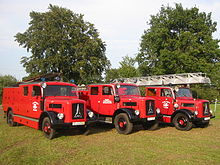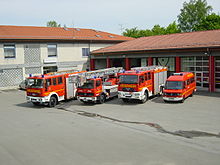Fire engine


The fire fighting platoon is a tactical unit in platoon strength whose primary task is to fight fires . In Germany , a train according to fire brigade regulation 3 consists of 22 emergency services in two groups and one platoon. Depending on the regional deployment and deployment regulations , fire engines can also be used for technical assistance .
Size and composition
The fire engine is colloquially equated with a fire engine . However, according to the definition, it consists of 22 emergency services on or in their device, i.e. in each case a combination of several vehicles. For organizational reasons, there are often more than 22 people on the fire engines. Especially in rural communities with several districts, the volunteer fire brigade of the respective district or village usually provides a single fire engine . On the other hand, professional fire brigades often operate fire engines with significantly fewer than 22 people for cost reasons.
Especially in the case of larger fire brigades, a fire brigade is often composed of the respective teams
- a command vehicle , usually a command vehicle (abbreviation: ELW), which transports the platoon and
- a group that is transported with a fire fighting vehicle . Another group is divided into
- a squadron from the tank tender or another fire fighting vehicle and
- a squad on the aerial rescue vehicle .
In this case, it is the tensile strength with fourth / 17/ 22 to.
This vehicle combination is quite common, but not mandatory. It is also possible to combine two fire fighting vehicles and a command vehicle or a fire fighting vehicle, a tank fire engine and a rescue vehicle or large tank fire engine or similar. A combination of pre-extinguishing vehicle, fire fighting vehicle (LF) or emergency fire fighting vehicle (HLF) and aerial rescue vehicle is also widespread among professional fire brigades . In some cases a platoon does not have a platoon; the train driver then drives on the first fire fighting group vehicle.
An extended fire-fighting train can also be used in particularly dangerous situations. A fire engine can be expanded by one vehicle up to the group size. After the valid until 2005 fire brigade service provision 5 ( the train in Löscheinsatz ) there was talk of an extension for a further troop (0/1/2/ 3 ).
See fire protection service for the fire protection services according to federal regulations.
In some major German cities, the fire-fighting train is supplemented by an ambulance as standard . This primarily travels with you for self-protection, so that no rescue equipment has to be requested for provision. The fire brigades from Munich, Braunschweig or Augsburg are an example of an extinguishing train supplemented with RTW.
Fire fighting train according to AGBF
In addition to this classic fire fighting train, there is still the AGBF fire fighting train in Germany (AGBF = Working Group of Heads of Professional Fire Brigades). In contrast to the classic fire-fighting train, the AGBF fire-fighting train only provides a crew of 16 fire brigade members for the criterion of a critical apartment fire.
A fire fighting train according to AGBF can also be put together according to the rendezvous system at the place of use, i.e. H. Vehicles from several locations complement each other at the deployment site for the fire engine.
Usually such a fire extinguishing train consists of
- a command vehicle ELW (1/0/1/ 2 occupied) as a guide vehicle,
- two fire engines, e.g. B. HLF 20/16 (each with a scale 0/1/5/ 6 ), and
- a turntable ladder, e.g. B. DLA (K) 23/12 (0/1/1/ 2 busy).
Thus, a thickness resulting from 1/3 / 12/ 16 fire fighters (SB).
Individual evidence
- ↑ a b Fire Brigade Regulations 3. (PDF) Units in fire fighting and rescue operations, Federal Office for Civil Protection and Disaster Aid, 2008
- ↑ Fire protection service (BsDi) in disaster control. Proof of strength and equipment of fire-fighting train extinguishing and rescue (LZ-R). STAN no. 011. Status: May 1984. (PDF) BBK / BZS
- ↑ Fire protection service (BsDi) in disaster control. Proof of strength and equipment of the fire extinguishing train and water supply (LZ-W). STAN no. 012. Status: May 1984. (PDF) BBK / BZS
- ↑ Munich fire brigade. In: München.de. Retrieved December 4, 2019 .
- ↑ Tactical Units - Disengagement Order. In: Braunschweig.de. Retrieved December 4, 2019 .
- ↑ Professional fire brigade. In: Augsburg.de. Retrieved December 4, 2019 .
- ↑ It concerns an apartment fire on the upper floor of a house with a smoky escape route (stairwell) and with human lives in danger; further information also under deadline .

